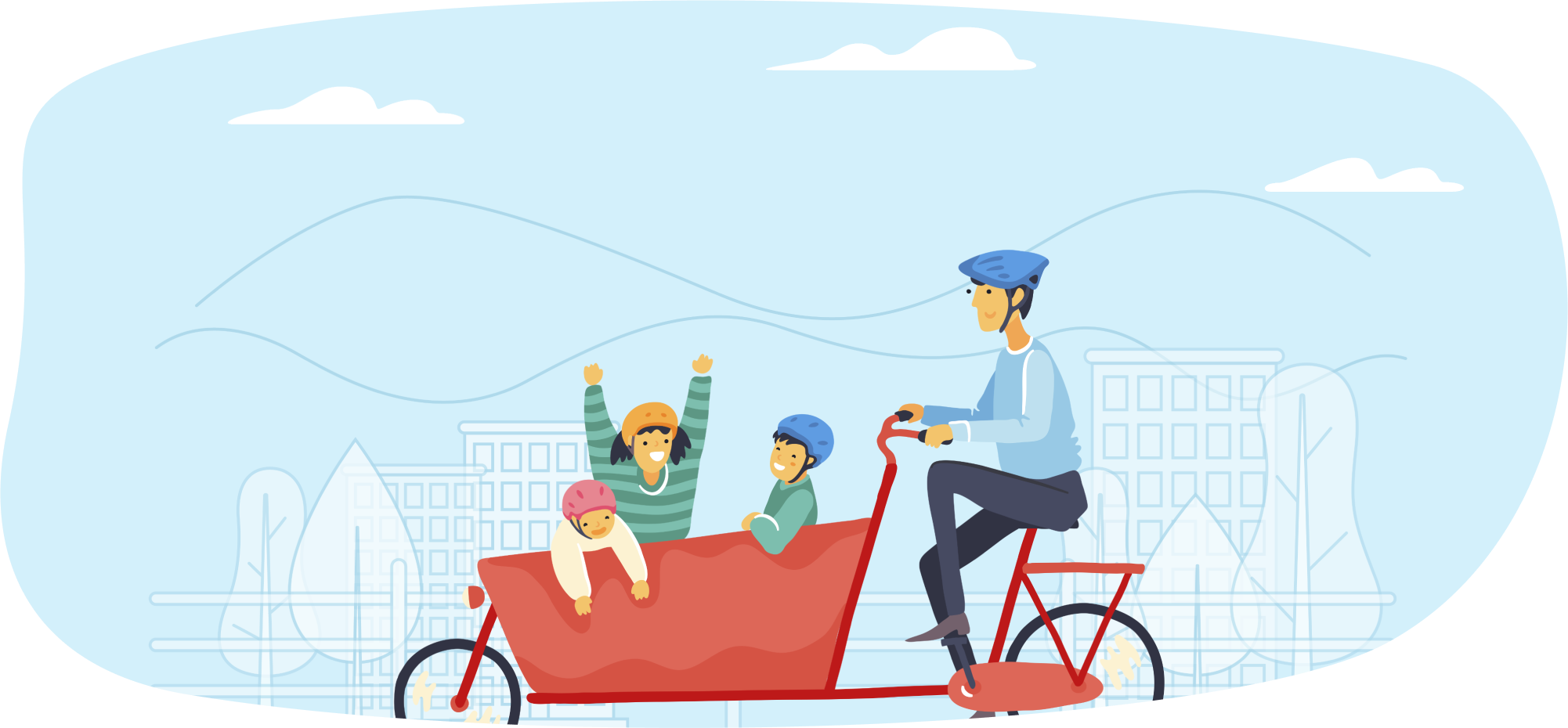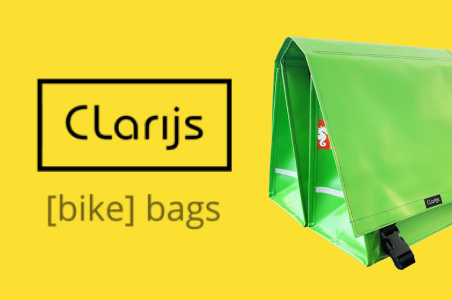People who bike love biking. If you’ve ever been on the outside trying to understand why exactly they love it so much, you may have heard something like this: “it’s just such a nice way to get around the city and I love the way the city looks on a bike.” Or maybe they told you biking cuts away stress from navigating rush hour traffic and saves time finding parking. They probably mentioned the fun factor or perhaps they said something even more dramatic: “Biking changed my life!”
People seem to come alive when they talk about biking, and it must be contagious, because the numbers are growing, especially in cities.
As more families move to and stay in cities, they are turning to biking as an enjoyable, sustainable way to get around.
You’ve probably seen bike families in your own city—pedaling a brightly colored bike with rear seats filled with kids or a bucket in front with a few bobbing heads and bags of groceries. Perhaps the idea of biking with your kids has piqued your interest enough for you to google it yourself, only to find a world of information that’s so confusing you close the tab, overwhelmed. If so, this handbook is for you!
We created this handbook to be an introduction for city parents who are interested or seriously considering biking with kids. It’s an overview of bikes suitable for hauling your offspring and a guide for how to decide which one will be best for your family. Throughout the handbook are nuggets of advice and real-world experience from bike shop owners, experts, and resources to connect you with families who have been biking for years.
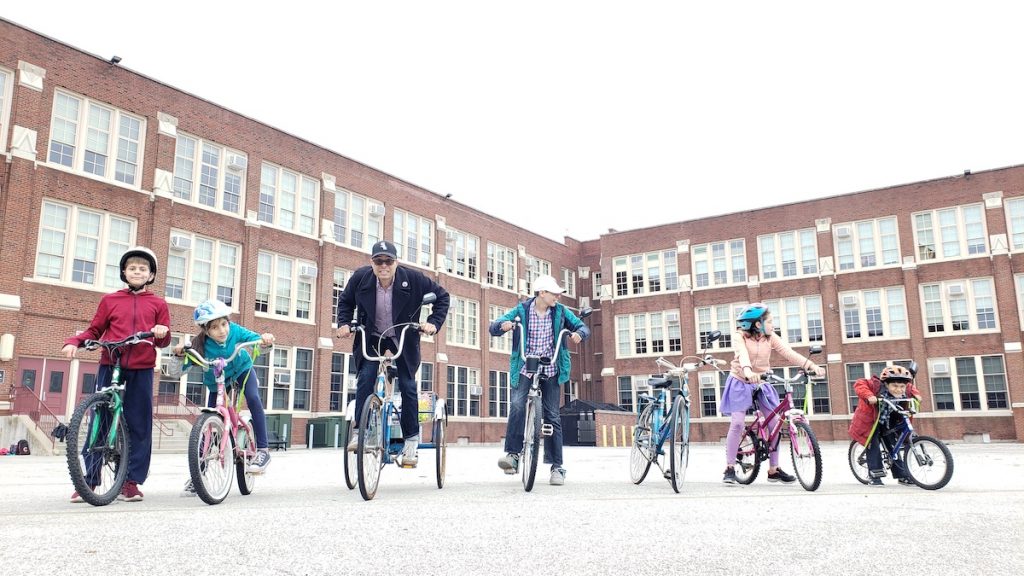
Introduction
Biking is a remarkable way to exercise, build memories, and get around your city, all while burning zero BTUs of energy, using no gasoline, and building a rich connection and sense of place to your city and neighborhood. Families across the world bike together in one way or another, and we’d like nothing more than to help more families experience the joy of it. And hey, we can fight climate change while we’re at it.
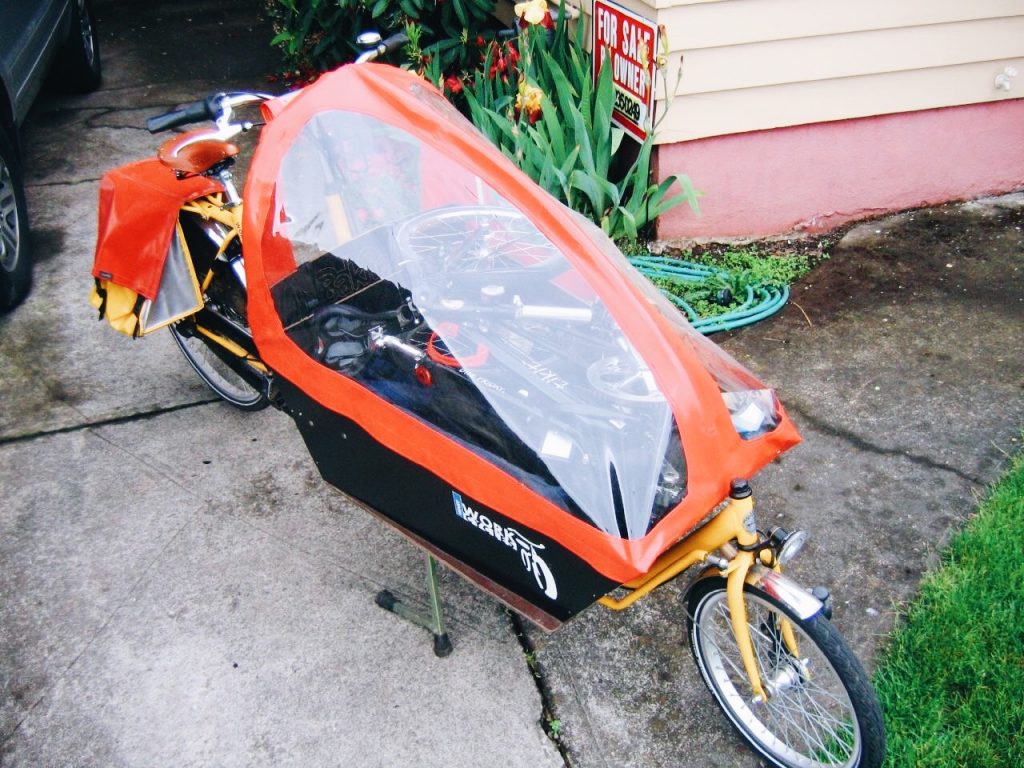
Use this handbook by clicking through the table of contents in the sidebar to skip over sections you don’t care about or jump to the section you need help with. We aren’t suggesting any particular style or brand of bike because each family has different needs and wishes and each bike is suited for a variety of different scenarios. Instead, we’re offering a thorough introduction to family biking in the city, and hope it will answer the basic questions you may have as you begin your research.
As you read, you’ll notice a particular phrase coming up over and over: talk to your local bike shop. We can’t say enough good about our local bike experts and there’s no resource as good as the decades of real-life experience and the testimonials of real parents who have become experts at biking with kids. We included a list of our favorite bike shops and cycling resources at the end of the article.
If you’re not convinced biking is right for your family or not sure you live in a city that’s conducive to this kind of lifestyle, that’s ok! But if you’re hoping to be convinced or just curious, read on. Families like you love biking, and who knows—next summer you might be exclaiming to a fellow city parent “I know my city so much better now that I bike!”
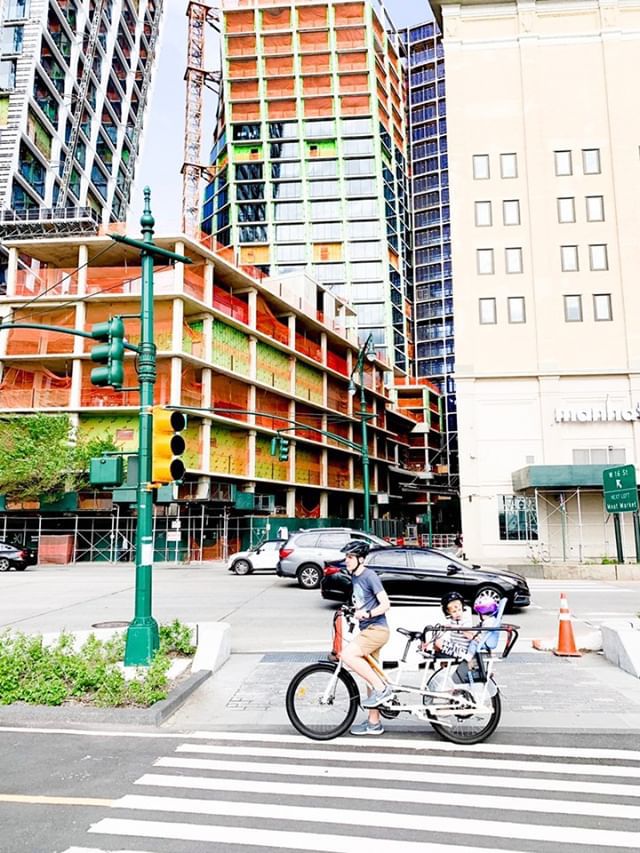
Types of Family Bikes
Family bikes come in a variety of orientations and combinations for a variety of budgets and family sizes. In other words, there’s a bike for every family, it’s just a matter of finding the right fit.
In this section we’ll break down the different types of bicycles best suited for family riding, give short descriptions of each, hear tips from experts, and give considerations to help the decision-making process for urban families everywhere.
Electric Assist (aka power boost)
Every bicycle everywhere is pedal-powered, and some even offer an extra boost with electric assist. Pedal-assist or electric-assist bikes combine parent power with electric power and often have an on-off switch so you can add the boost when you need it.
As more cargo bikes come on the market, there are more options that include electric assist, and you’ll have to decide if your needs require it. Talk to your local bike shop and other families in your city. Most experts recommend it for large or heavy bikes, long rides, or if biking is your main form of transportation. Unless you’re LA Bike Dad. He likes the extra exercise only pedal-pushing gives, and says it “forces me to grind my way up hills [and] makes me happy in a weird way.” Test ride both and find what works for you.
Adding e-assist to a bike you’ve already purchased isn’t always as simple as it sounds. If your family plans to ride for several years and your goals are to have a car-free or car-light lifestyle, you’ll probably want e-assist. Conversion kits are complicated and can be expensive, so if you have even the smallest suspicion you’ll want electric assist in the future, take time to do your research and talk to experts about your options.
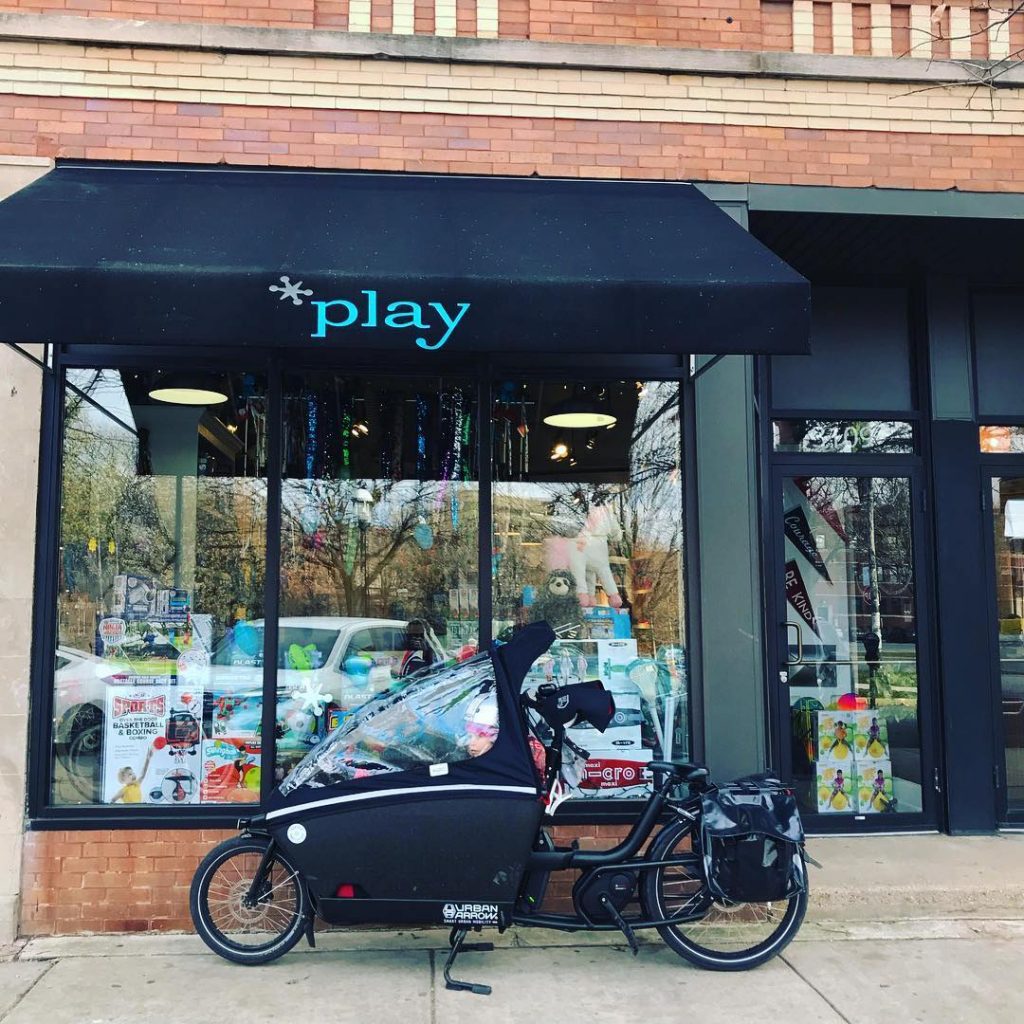
Biking with your kids happens one of two ways—with an attachment on your existing bike or with a cargo bike designed specifically for hauling larger loads.
Bicycle Attachments
Add-ons to your existing bike are a popular and accessible way to begin biking with children, and are often a parent’s entry into the world of family biking. It’s not hard to understand the progression: if cycling is an enjoyable and substantial part of your life, it’s only natural to want to share that with your child after you become a parent. Bike seats and trailers are relatively inexpensive and readily available.
Child Bike Seats
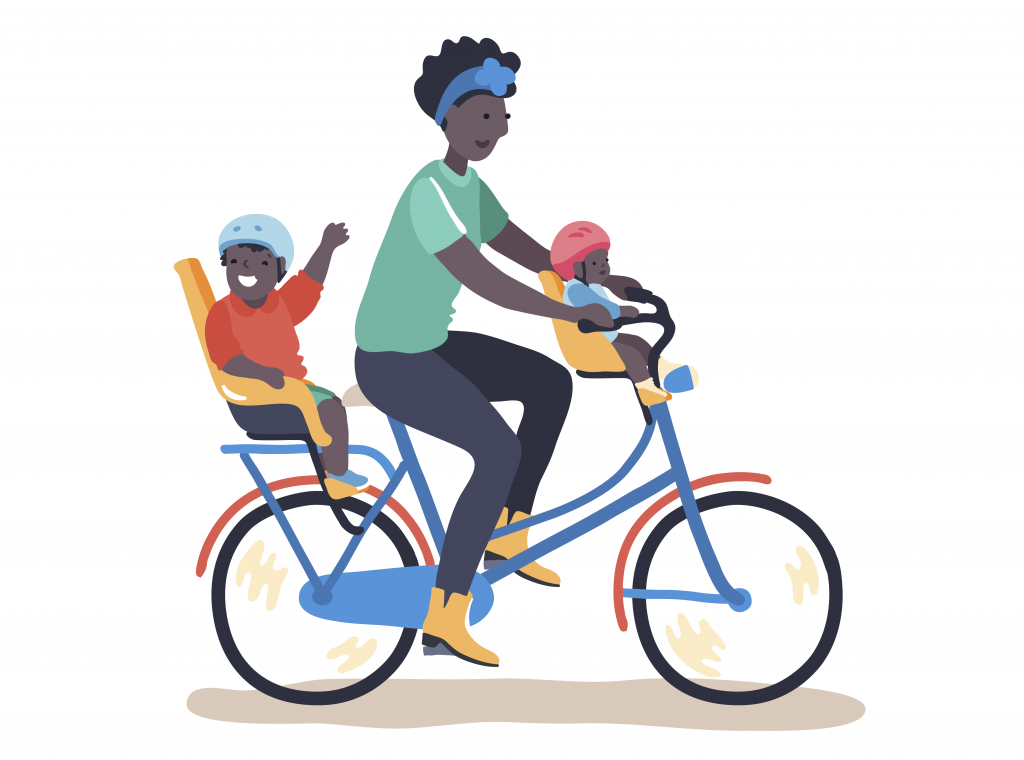
Seats for your child can be mounted on the front or rear of your bicycle. Each seat mounts in a specific way; most require a rack or ample space on the the frame or seatpost for installing the hardware. If you buy used or online, take it to your local bike shop for professional installation. You’ll thank us later.
Front-mounted seats allow your child to sit near the handlebars—they’ll feel super-close as you ride! The weight limit on these seats tends to be lighter than any other option for biking with your kids, so they’ll probably age out quickly.
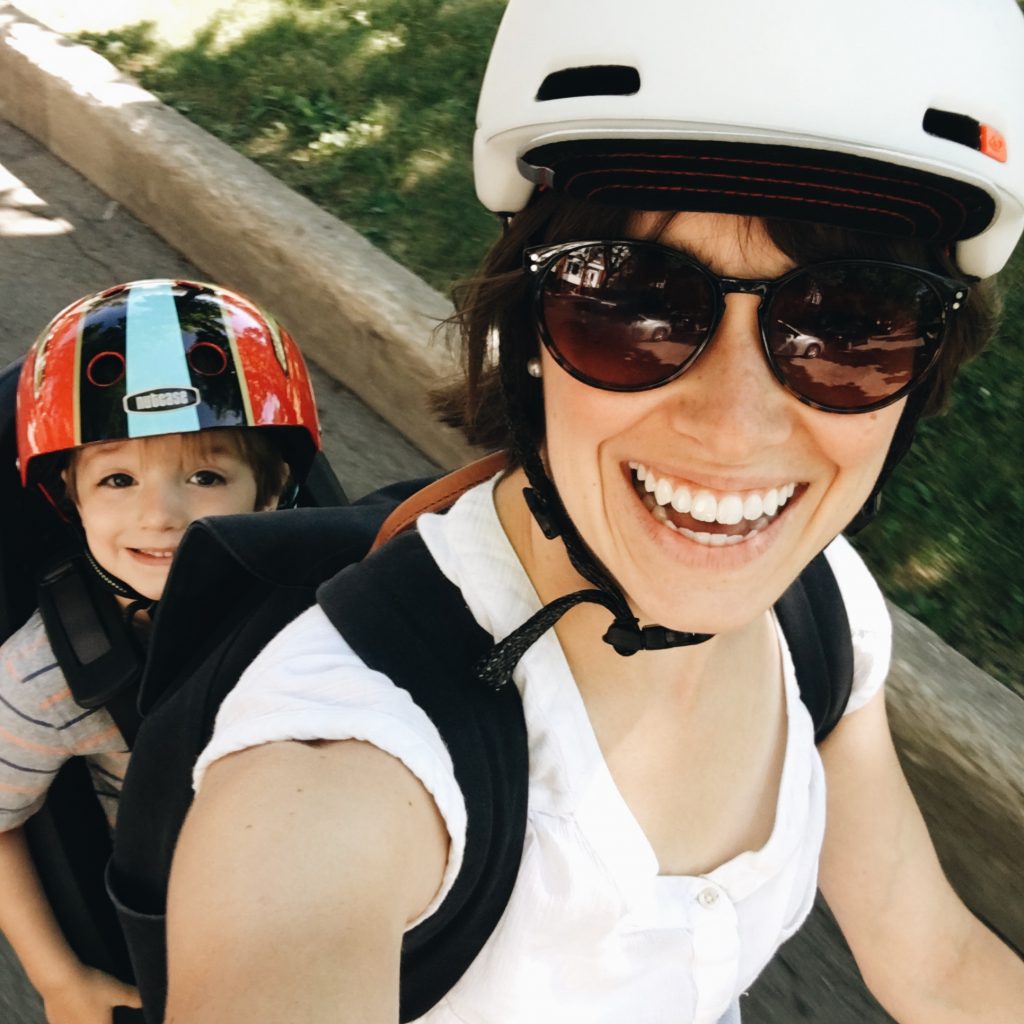
Rear-mounted seats have a wider weight range, allowing kids to ride in the seat until they’re a bit older. Even though your child will be riding behind you, the seat is mounted close enough to accommodate conversation—if your experience is anything like ours, you’ll find your kids to be very chatty during bike trips! It may seem like a non-essential detail, but being able to communicate easily with your kids makes the whole experience safer and more fun for both of you.
Considerations & Tips
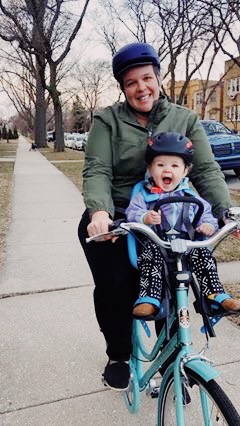
- Ask any professional and they’ll tell you a double kickstand is essential for mounted bike seats. Loading and unloading your child into the seat is the toughest part when it comes to staying balanced; a double kickstand takes away the fear of tipping. Order one the same day you get your bike seat and have your local shop install it properly for you.
- The heaviest weight limit we’ve seen for a bike seat is about 50 pounds, meaning kids typically grow out of them in just a few years. Bike seats are a perfect entry into family biking, but if you’re hoping to use your bike as a main form of transportation for several years, you may want to consider a more long-term option.
- Mounted seats are one of the quickest and easiest ways to begin biking with your kids. If you’re not sure about family biking and want to give it a try, a used bike seat is one of the easiest and inexpensive ways to find out if it’s right for you!
- Biking with your kid in a seat gets tricky if you have anything else to carry with you—there’s not much space for extra bags or supplies. Wearing a backpack means your child feels cramped and uncomfortable (been there, heard those complaints). There’s always the option to add a front rack, but rear-mounted panniers are often incompatible with rear-mounted seats. If you need a bike to do a lot of medium- or heavy-lifting for you (groceries, anyone?) you may want to consider another option.
- Not every bike is well-suited for a bike seat. You might need to swap out your lightweight frame (like aluminum) or hipster fixed-gear bike for something stronger that can adequately support the extra weight.
Bike Trailers
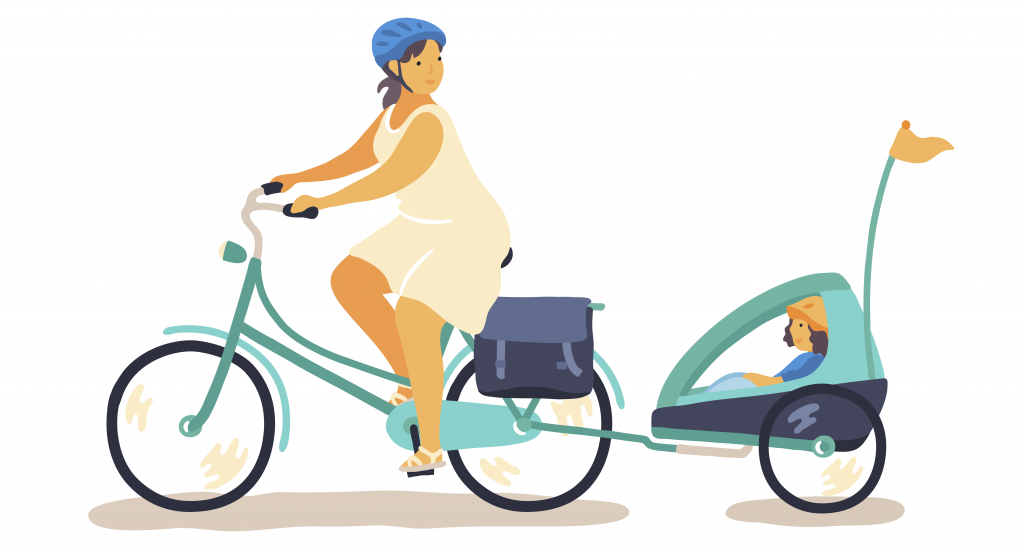
Trailers pulled behind a bike are another popular way to ride with your kids using the bicycle you already own. Mounted to the rear axle or seatpost of your bike, trailers do just that—trail behind you. They offer plenty of storage room for taking along supplies and all the other stuff we always seem to accumulate when traveling any distance with our kids.
Trailers can be as fancy or as basic as your budget allows. There are convertible options that unhitch from your bike and transform into a stroller once you reach your destination or the basic trailers you’ve probably seen on any and every bike trail.
Weight limits are typically higher than bike seat limits, but grade-school-age kids will feel cramped, and any age kid will find it near impossible to talk to you from a few feet away in the trailer.
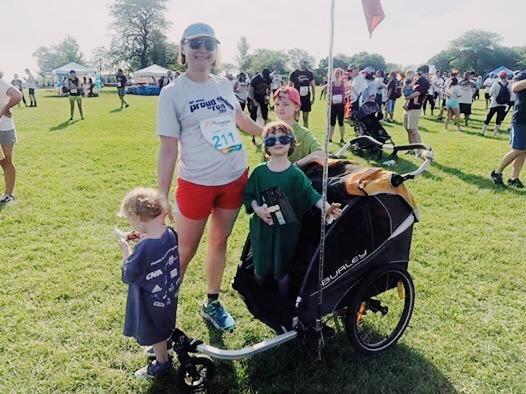
Considerations & Tips
- No one wants to think about theft when deciding which bike is right for you, but if you’ve saved your money and taken the plunge on a family bike option, the last thing you want is for it to wind up missing. Some trailers are easy to unhitch and walk away with; chose one that requires custom tools to unfasten or be sure you have a secure way to lock it to your bike.
- Experienced parents and cycling experts worry about visibility when biking with a trailer in mixed-use areas (aka streets). Always, always use a flag.
Trailer Cycles
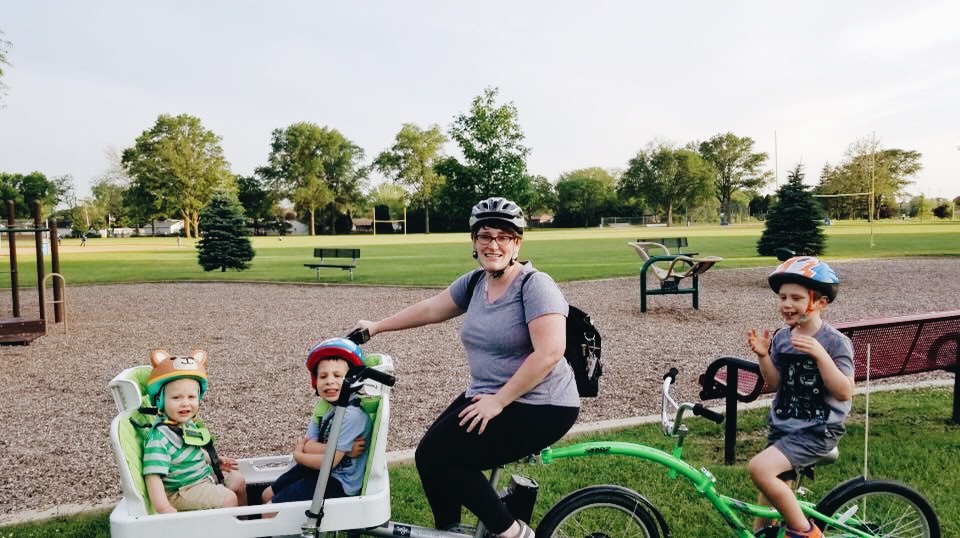
Trailer cycles are the final type of bike attachment. Also called trailer bikes, trail-a-bikes, tag along bikes, or trainer bikes, these are mounted behind a parent’s bike and offer kids a chance to be more involved in the biking experience. They come with a seat for the kid, handlebars, and sometimes pedals and fill the sweet spot when kids are too big for other options (like a bike seat) but not quite ready to ride solo.
Trail-a-bike attachments come in three styles, standard (one wheel and a standard bike seat), recumbent (a chair with safety harness and pedals riding low to the ground), or tow bar (pulls child’s two-wheel bike behind). Standard attachments are the most common and feel the least wobbly to the rider.
Considerations & Tips
- When choosing your trailer cycle, be sure you have a compatible bike to attach it to. Most attach to the seat post of your existing bike and some mount onto the rear rack.
- The biggest complaint with trailer cycles is that they feel wobbly, especially recumbent, tow bars, and seat post mounted trailers. Rear rack mounted bars offer more stability as well as seat post mounts with fewer connections.
- Visibility is an important consideration with trailer cycles. Many models come with flag included!
- We’ve seen trailer cycles attached to more than just standard bicycles. You might even be able to attach one to your cargo bike and transport even more kids. Who needs a minivan anyway?
Cargo Bikes
Cargo bikes (also called freight bicycles, carrier cycles, freight tricycles, cargo bikes, box bikes, cycletrucks, and bucket bikes by some) are “human-powered vehicles designed and constructed specifically for transporting loads.[1]” When it comes to family biking, those loads are children, groceries, gardening supplies, the family dog, backpacks, library books, beach day essentials, and more.
Generally, the term cargo bike refers to any bike that carries more than one rider, but we’re using it here to categorize larger bikes that can haul the most kids. There are four main types, all with different strengths and specs to accommodate different needs.
Midtail/Longtail
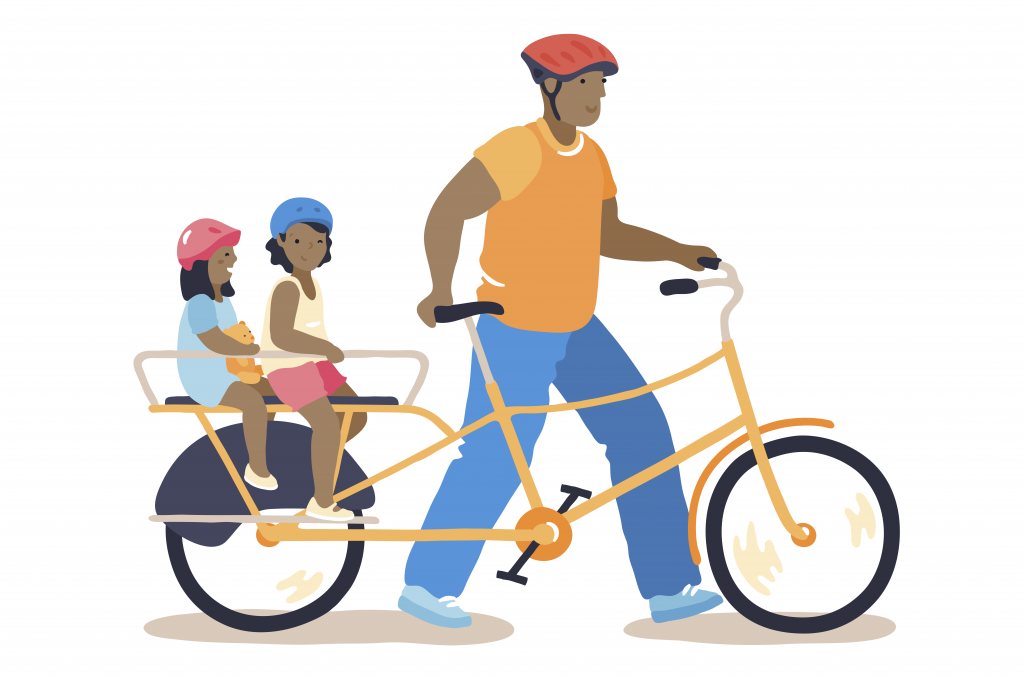
Longtail and midtail bikes are exactly what they sound like. A longer wheelbase (the distance between front and rear wheels) allows for a space behind the driver’s seat to support a bench and often handrails where kids can ride. There are as many configurations to a longtail cargo bike as you can dream up, and they’re highly customizable to kids of different ages and heights. They’re the cargo bike that looks and rides most like a two-wheeled single-rider bicycle, so they’re a good choice for many.
Considerations & Tips
- Longtail manufacturers have gotten smart and nearly all of the newer models have a smaller rear wheel. This keeps the deck height (the place where the kiddos sit) lower, the center of gravity lower, and means the bikes feel less likely to dump over and are easier to handle.
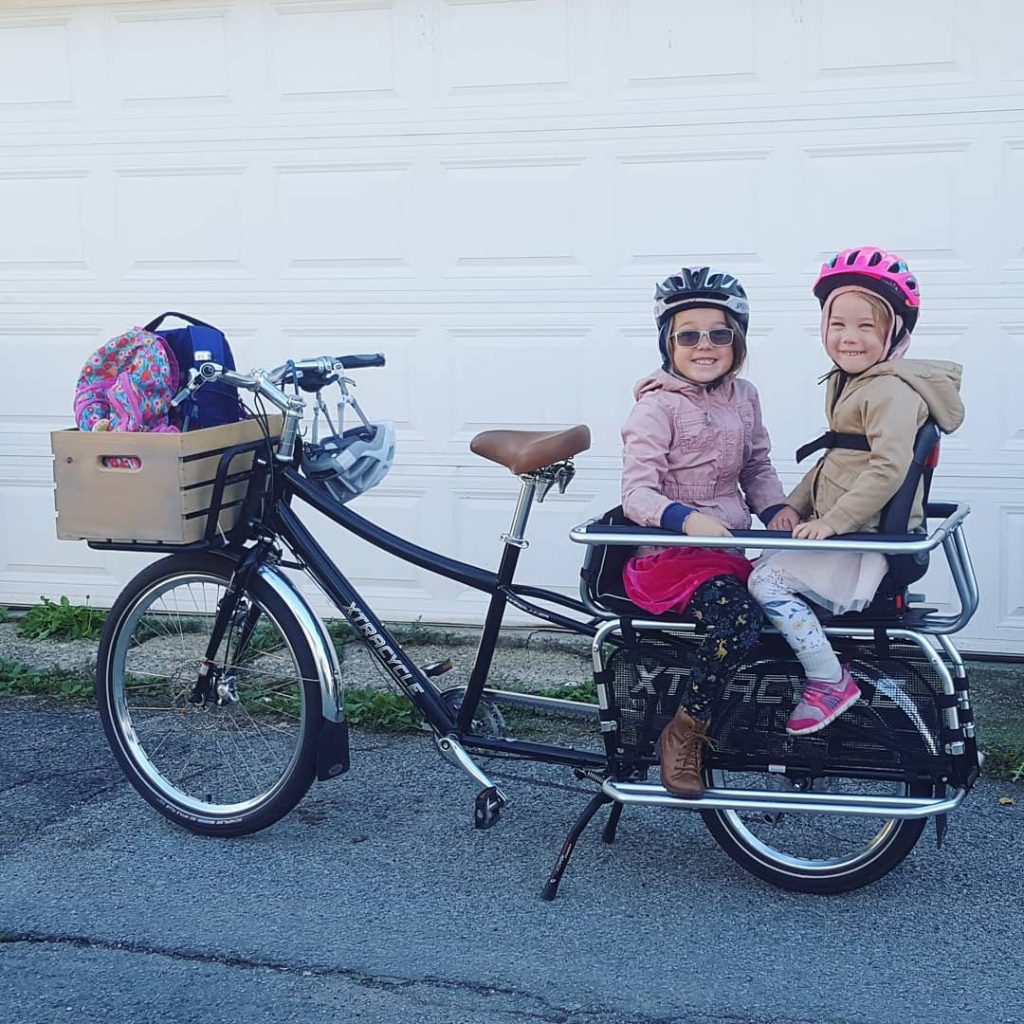
- Longtail bikes are most similar to a “regular bike”, which means they feel and handle like a regular bicycle too. The learning curve is easier.
- These bikes are typically the least expensive and most lightweight when it comes to cargo bikes.
- Kids are exposed to the weather on a longtail more than on a bucket bike that can be fitted with a cover. Keep that in mind if you live in a place that sees a lot of rain or cold weather.
Bakfiets
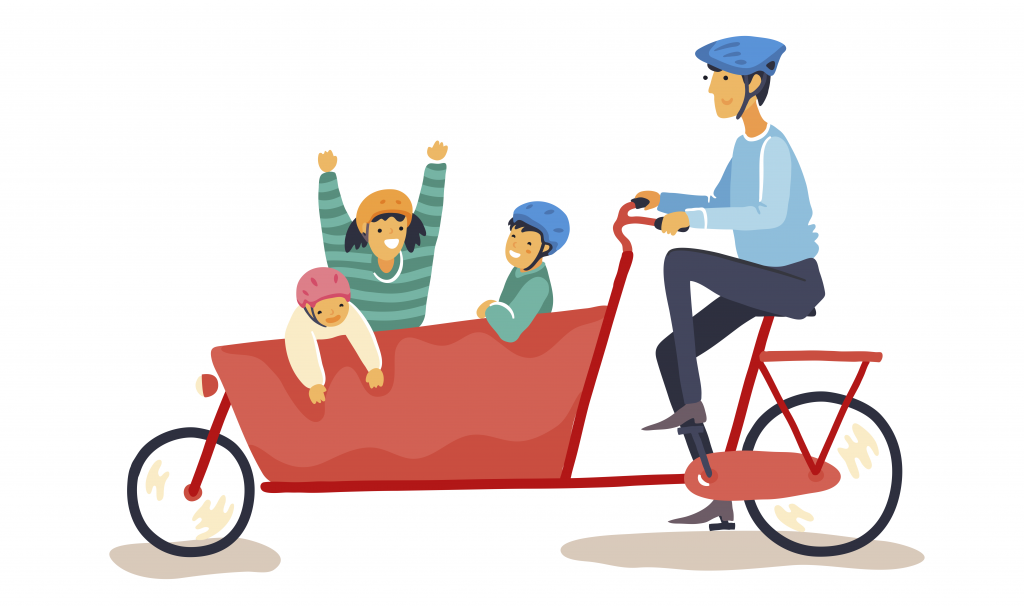
Aka “bucket bike”. These are the iconic cargo bikes that first caught on in Europe many, many years ago. Fitted with a low box, basket, or sometimes platform in front of the handlebars, bakfiets (literally “bin bike” in Dutch) can carry a lot of stuff.
Bakfiets are the largest of all cargo bikes, are heavy, well-built, and offer the best protection from the weather for riders. They’re generally more expensive than other cargo options but have a long life (in terms of riders’ age) and a good resale value.
Perhaps the most attractive feature of bakfiets for city families is their carrying capacity. It’s rare to go anywhere with kids and not need to take other things along. Think groceries, additional offspring, beach day gear, ball game supplies, picnic food, et cetera. They’re known as a two-wheeled minivan for good reason!
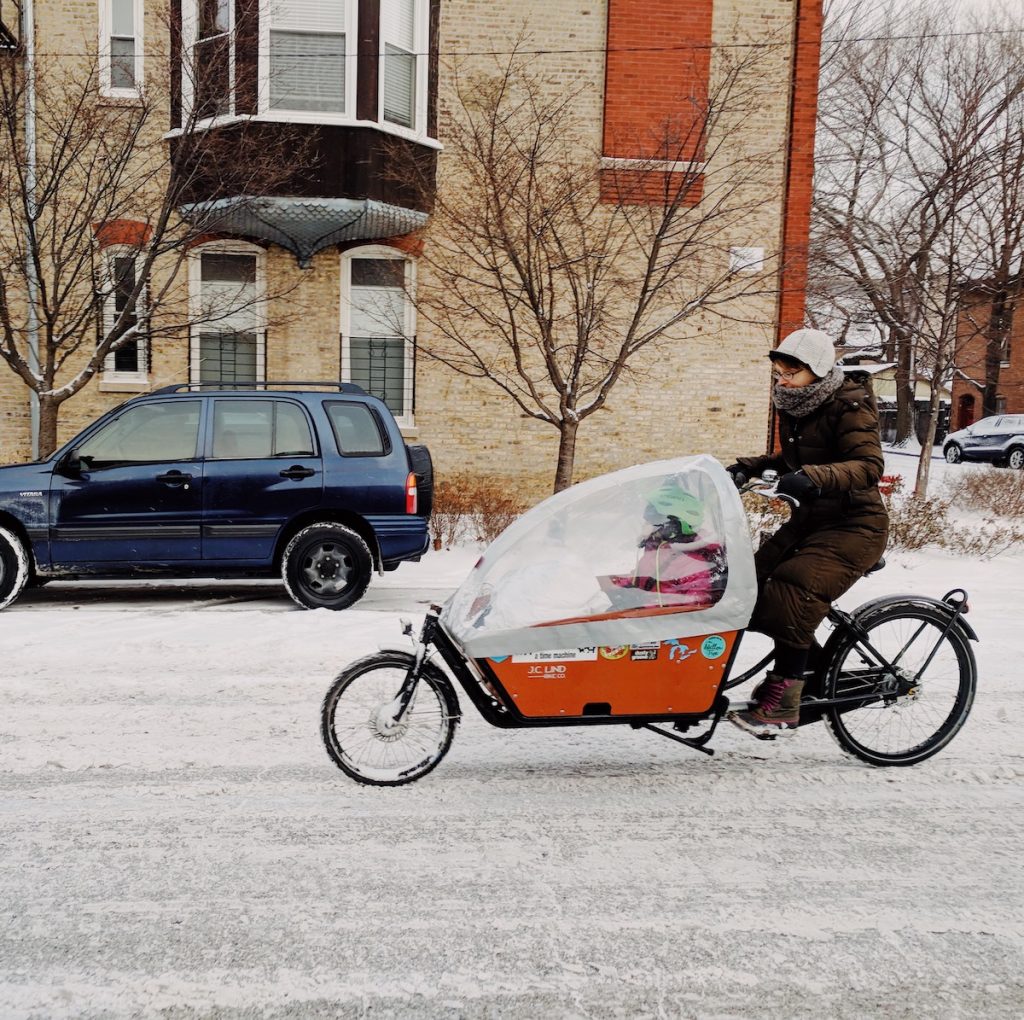
Considerations & Tips
- To put the price tag into perspective, bakfiets and other box bikes weigh around 100 pounds before adding kids, rider, and stuff. That much weight needs a solid brake system in order to allow quick, safe, and reliable stopping. Brake systems on cargo bikes are often much more sophisticated than your average single-rider cycle, and that’s a big reason why these bikes are so much more expensive.
- Most bakfiets come with the option to add electric-assist. These bikes are heavy (see above); you’ll want e-assist.
- Bikes with the cargo box mounted in the rear are essentially a long tail fitted with a box. They hold as much cargo as a bakfiets but are sometimes rated for more weight capacity. If you’re transporting live, talking cargo (aka your kids) you may find it challenging to carry on a conversation when they’re behind you. Although rear-mounted cargo bikes can be a little less expensive, many parents cite limited conversation as the reason they decided against them.
- Storage space for the bike is a top consideration when it comes to bakfiets; without superhuman strength or an elevator big enough you can’t get it up off street level into an apartment, and some bike storage rooms in apartments aren’t big enough. If you don’t have garage space, a ground anchor, protective cover, and ultra-sturdy chain lock might be your best combo.
- Bakfiets can be fitted with a cover to protect the smallest riders from rain and snow, and umbrella-type covers offer shade when it’s super-sunny. If you’re planning to become a year-round cyclist, you’ll want some of those add-on accessories.
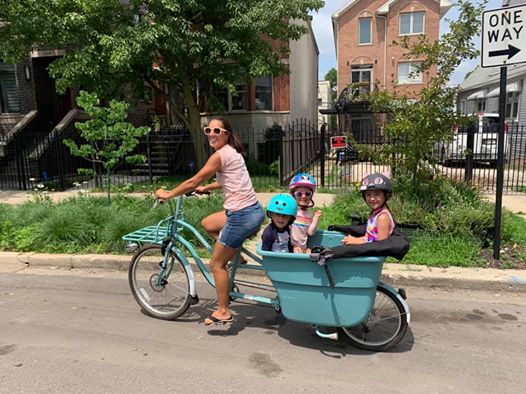
Front-Load Trike
The third and final style of cargo bikes is the trike. Exactly what it sounds like, the cargo box is supported between two front wheels. Parents often chose a trike because it seems as if it’s a more stable cargo option, but operating it—especially steering—has a learning curve.
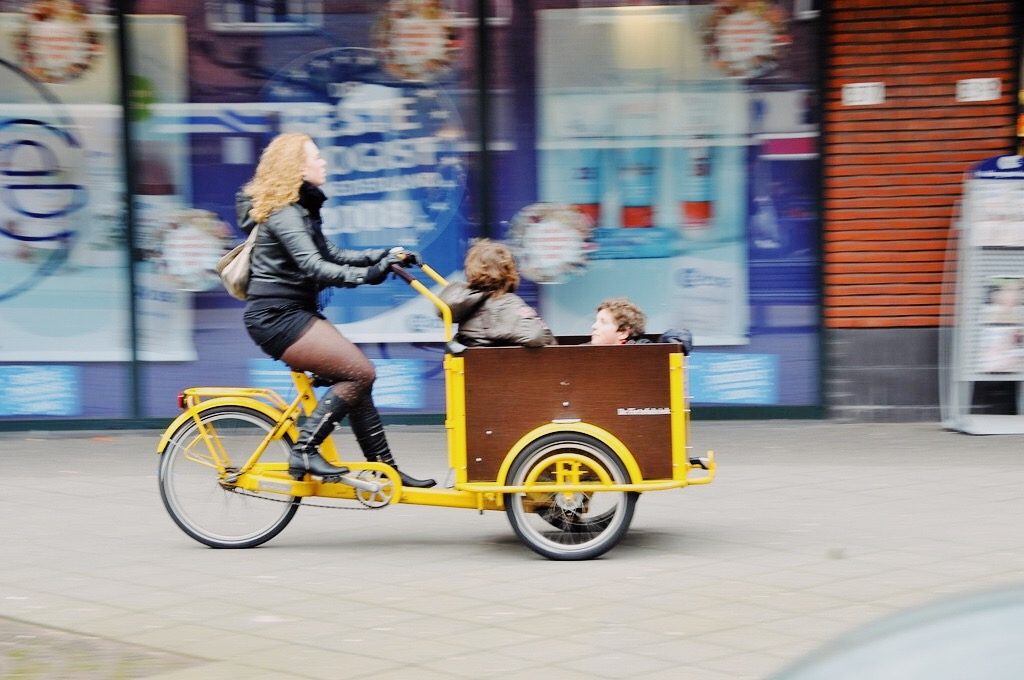
Trikes are similar to bakfiets in carrying capacity and are sometimes rated for even heavier loads since the weight is distributed across two wheels instead of one. Rain and snow covers are available for trikes, and the price tag is similar to a bakfiets as well.
Considerations & Pro Tips
- At first glance, trikes seem ultra-stable, and they are when stopped or at slow speeds. They become harder to manage at higher speeds, however, especially when steering.
- You’ll want e-assist with a trike too; it might save you money to do without, but the bikes are heavy and you’ll be able to ride for longer with a little boost.
- Many cyclists are thrown off by the way steering feels on a trike. Take a test drive before you buy!
- Trikes lean with the camber of the road—that’s the slight convex shape of the surface of the road. If streets in your city have a significant camber, you’ll often feel as if you’re riding lop-sided! Look for the trikes that have a tilting mechanism to offset this.
Choosing the right bike for your family
When picking the right bike for your family, there are a handful of things to keep in mind, some big-picture ideas about your lifestyle. They’re not meant to overwhelm you or paralyze you in the decision, but just to help you pick a bike that can grow with your family and that will work well in your particular city. Here are the most basic questions and considerations families keep in mind when deciding which bike is the best for them.
Consider your city
Not all cities are created equal, and that’s why they’re so wonderful! Take note of your city’s terrain and personality as you search for the perfect family bike for you. San Francisco, Brooklyn, and Vancouver have hills and elevation changes that make for beautiful views but tricky biking. Chicago, Phoenix, and New Orleans, on the other hand, are known for being pretty flat and are well-suited for biking. These details about your city will help you decide whether you’ll need electric assist for your family bike or if you can get away with pedal power alone.
The presence and priority of bike lanes in your city is also something to consider. If your city is actively installing bike lanes or has already given a good chunk of their budget to creating them (a la Portland), you’ll be a very happy biker surrounded by many other happy bikers. If bike lanes (or quiet one way streets) are scarce, you’ll want to think about which bike will make you most comfortable riding among car traffic.
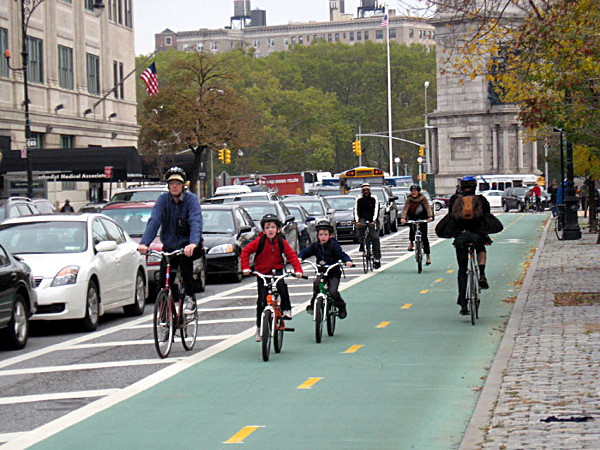
Many cities have a biking community, and the level of engagement and involvement is a good indicator for how much your city cares about its cyclists and how quickly you’ll be able to feel at ease on your bike. We highly recommend searching for online communities or talking to your local bike shop to discover and join the biking community near you. They often host rides throughout the city, and you’ll be able to talk to other parents for advice or ask to test ride bikes as you make your decision.
Consider your habits
Take a moment to think about how biking will fit into your life. Where and how often will you bike? What’s the longest distance you expect to ride regularly? Will it be your only form of wheeled transportation? What will you carry with you when you ride?
These questions will help you get a sense of how you’ll ride. Maybe your main goal is to bike the kids to school and continue on to work. Perhaps you don’t have a car and are hopeful the bike will service your longer trips and grocery hauls.
Barb Grover owns Splendid Cycles in Portland and says you might be surprised how much you’ll use your bike once you have it. Many of her customers plan to use the bike to take their children to school. “I’ll see them a few months later,” she says, “and they tell me they are selling one of their cars! They discover two things: 1) how fun and easy it is for them, and 2) how much the kids love and typically prefer to go by bicycle. So, what was purchased as a “school bus” is now a camper, a grocery-getter, a errand runner, dog-hauler, a daily commuter.”
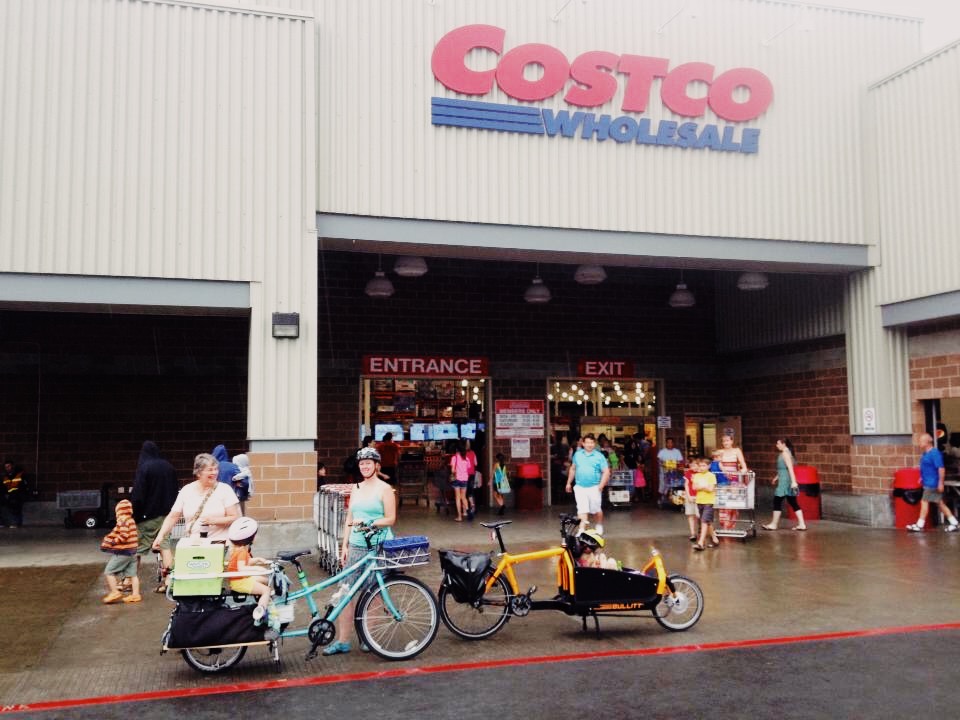
As you think about the habits that you have or want to have as a biking family, you’ll begin to see which bike will be best suited for your needs and preferences.
Who will ride the bike?
How old are your kids and how long will they ride? Kids who are out of the infant stage can ride and fit on every style of bike, depending on their height and what’s comfortable for them. If you’re planning to carry an infant you’ll probably want a bucket bike that you can mount a car seat into.
Also keep in mind which parent will be providing pedal power; if more than one adult is planning to ride, you’ll want an adjustable bike that both are comfortable maneuvering.
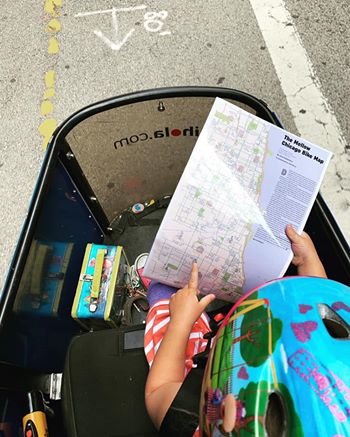
Set a budget
You don’t need to poke around on bike forums or manufacturers websites for very long to know that bikes are available at almost every price point. It’s helpful to set a budget in advance so you know what you can afford. Buying used family bikes is also an option, and if you’re patient enough, you’ll probably be able to find one you want from a local family or bike shop. If you’re new to biking, it’s wise to have the bike inspected by a professional.
Try before you buy
Experts at your bike shop will encourage you to ride a bike—cargo or not—before you take it home, and it’s good advice. Test-riding a bike first at your local bike shop will help you be sure it matches your family needs and handles in a way that you’re comfortable with.
Davey Oil at G&O Family Cyclery in Seattle says test rides are vital. “Ride carefully every cargo bike you can get your hands on. Ride it solo, ride it with your kids, and ride with kids who are older—remember it’s a long-term purchase.” It’s so easy to have assumptions about which bike we think will work for us (or which style would be much too hard). “You can feel confident with your own research,” Davey says, “but riding is like nothing else.”
Think about accessories
There’s more to buying a bike than buying a bike—you’ll need helmets if you don’t already own them, a heavy-duty and compatible lock, storage space and a way to secure the bike there (bikes stolen out of storage is more common than you might think and very, very sad), and a number of other accessories depending on your lifestyle and needs.
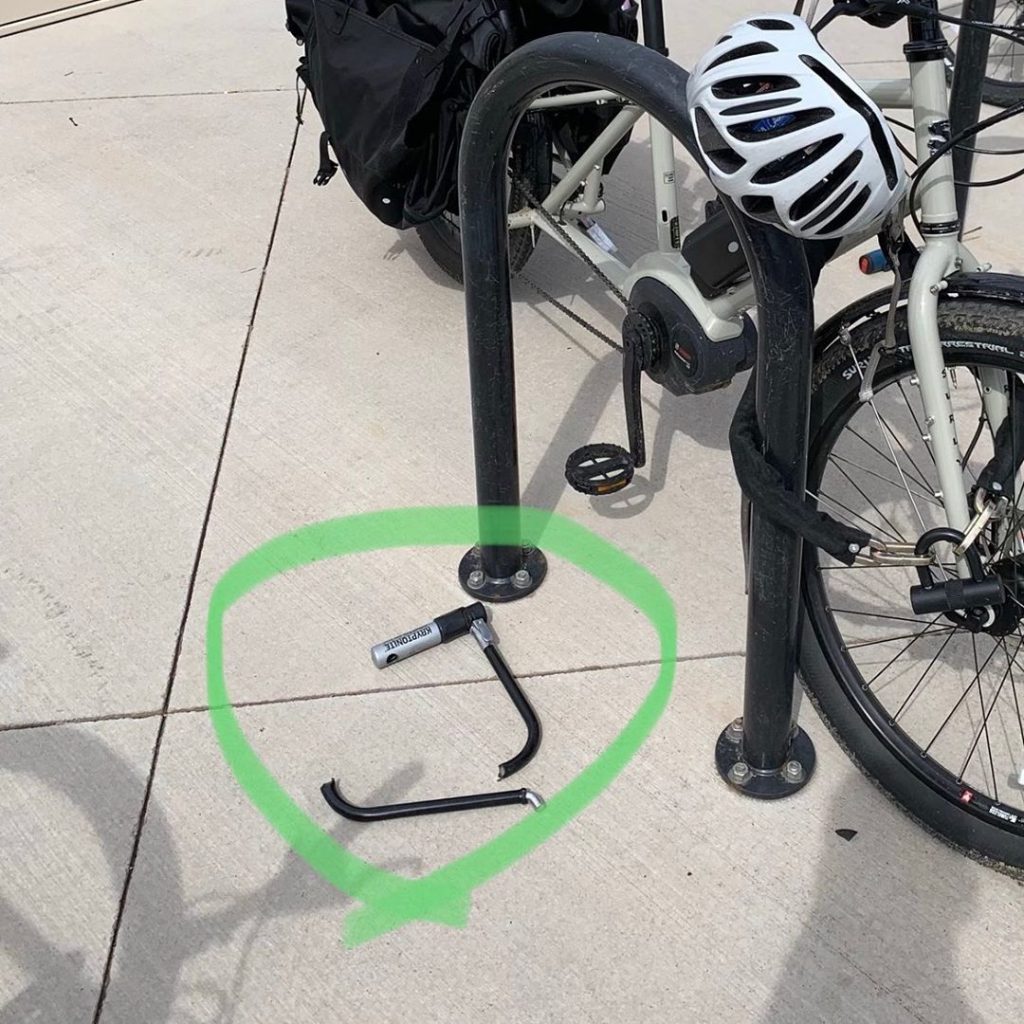
Arleigh owns Bike Shop Girl Family Cyclery in Denver and recommends using locks that match the value of your bike. “If your bike is more than $500 use 2 locks, more than $1500 get 2 locks over $100 when locking somewhere for a long period of time.”
Again, your bike shop experts will be able to recommend the best locks and accessories for the bike you’ve chosen and know how to best secure it in your city.
Find a bike shop
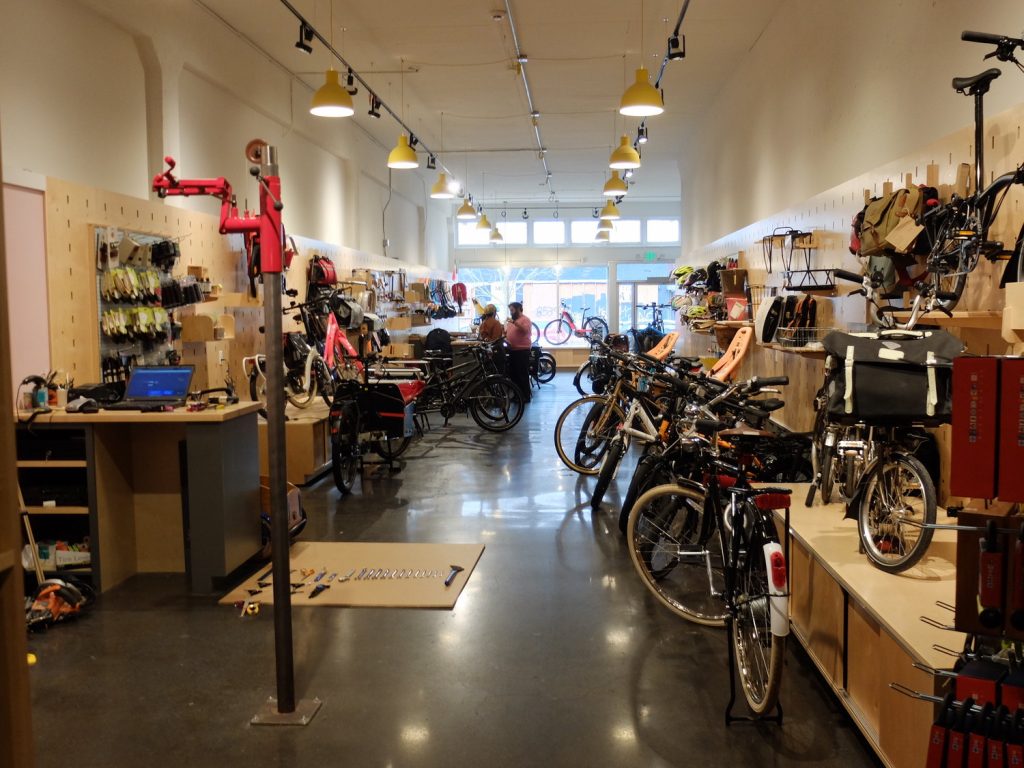
We warned you at the beginning of this handbook that we’d tell you to find a bike shop until you were tired of hearing it and we’re not quite done saying it. We created this handbook to help city families catch the vision for biking with kids in the city and help jump start the decision about which bike to buy. But to finish the decision, talk to a real human at a bike shop in your city. Building a relationship with them will pay dividends; they will become your go-to for dealing with manufacturer’s defects, installing accessories properly, and taking advantage of warranty service.
Bike shop owners like Davey at G&O Family Cyclery in Seattle are professionals in the business, and know what bikes are specifically suited for your city. “We don’t have every cargo bike ever made in our shop,” he says, “but we do know which bikes work in Seattle.” If possible, find a bike shop that’s family-focused who can help you with life beyond your purchase too. They will know how to get plugged in to your local biking community, can help you understand your city’s terrain and give route tips, and will be able to address specific questions about cycling in your city that we can’t cover here. We’ve got a list of our favorites at the end of the handbook.
There’s no flowchart or perfect answer to which bike is best for your family. It’s a complex decision that takes some time and thought and help from experts and friends.
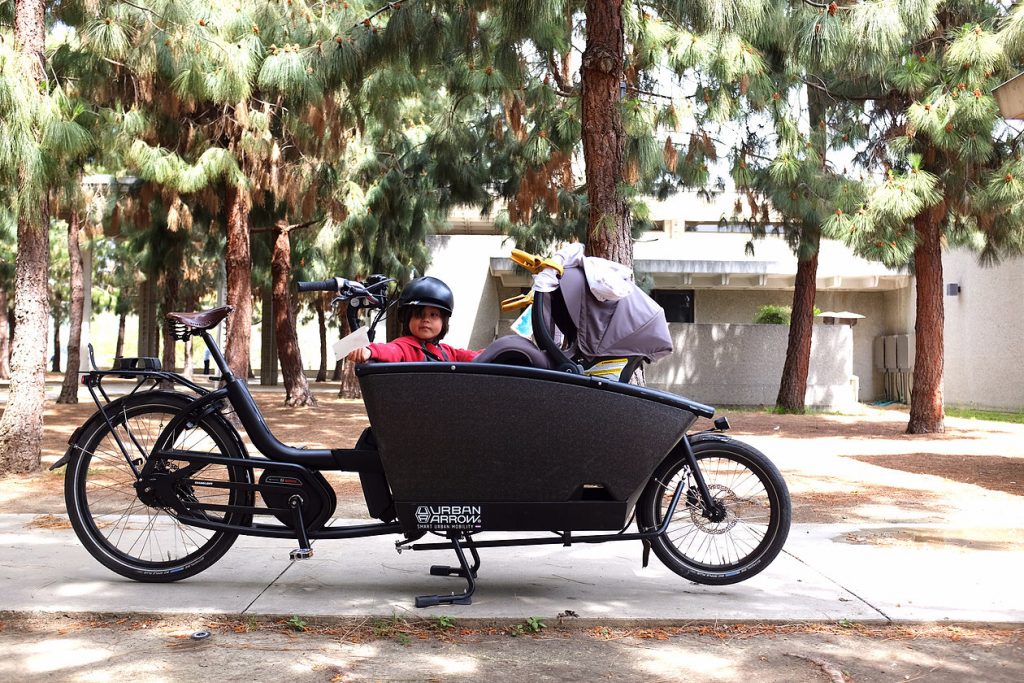
Consider your family’s needs and lifestyle, consult your bike shop, narrow down your choices and take some test rides, and then get ready to ride!
Ready, Set, Pedal!
Be safe! You’re itching to ride, but before you take the first trip make sure you’re prepared and safe. Give everyone a helmet that fits properly, be aware of hand signals to turn, and install the proper reflectors and lamps for low-light riding.
We learned about the 3-2-1 helmet fitting rule from Elsbeth Cool of Four Star Family Cyclery at her Family Biking 101 Class. It’s a common technique that follows these guidelines: Helmets should be no more than 3 fingers from the bridge of your nose, adjust straps so they connect in a 2-finger V-shape at each earlobe, and tighten so 1 finger can slide under the chin strap — not too tight, not too loose!
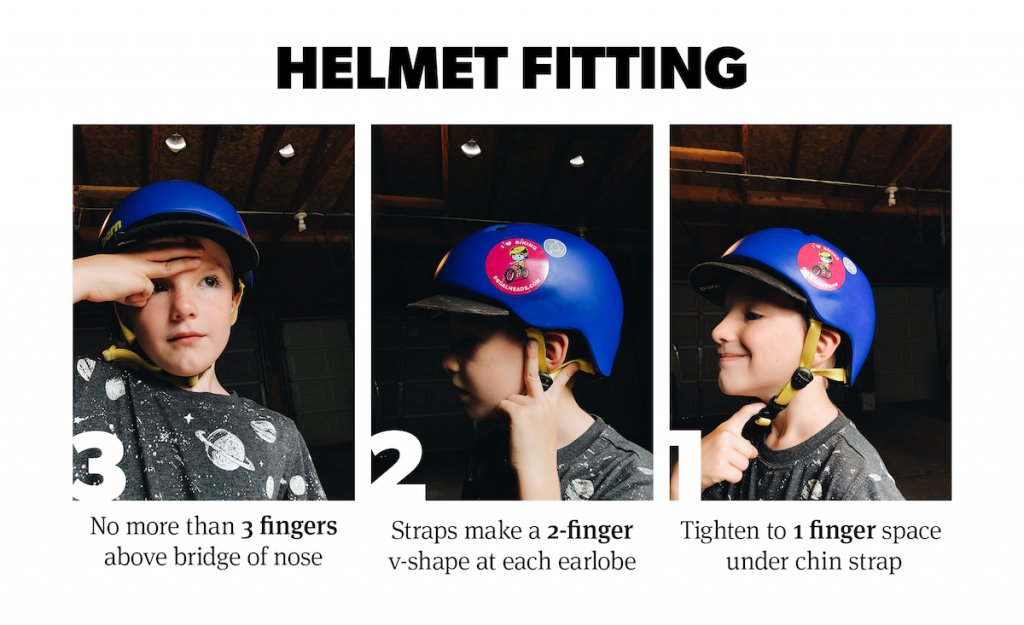
Whether you’re biking in a dedicated bike lane or alongside car traffic, use proper bike etiquette and read up on the cycling laws for your city. They vary from place to place; for example, sidewalk riding is prohibited in Chicago for cyclist older than age 12 but it’s perfectly legal in Los Angeles. It’s also wise to take a bicycle safety class at—you guessed it—your local bike shop. Here are some basics to get you thinking:
- Obey traffic laws (stop at stop signs, ride with the flow of traffic, etc.)
- Use hand signals
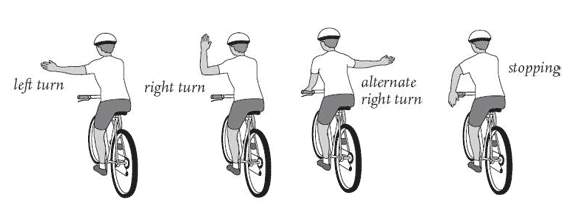
- Watch for pedestrians
- Ride on streets you’re comfortable with (for example, LA Bike Dad avoids streets with traffic moving faster than 25mph)
- Use your lane (if you’ve got a bike lane, use it. All of it. There’s no need to give it to the cars—they have their own lane)
- Make eye contact with drivers and signal clearly to them
- Stay alert and be prepared for unexpected obstacles and things outside your control. Don’t ride in the “door zone” of parked cars!
Accessories beyond helmets, a lock, and reflectors or lights aren’t essential, but they do make the ride fun! Here are our favorite cycling accessories.
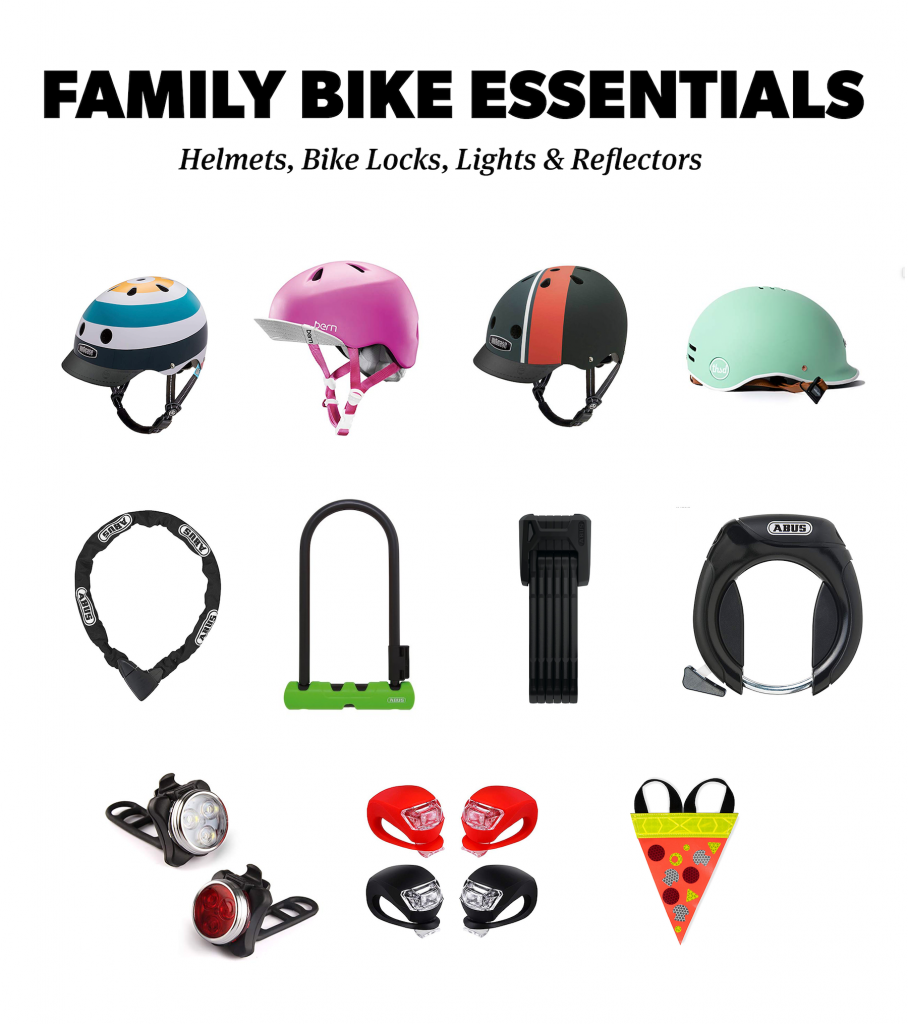
Locks: Abus Citychain, U-lock, Abus Bordo GRANIT, frame lock
Visibility: Ascher rechargable lights, Malker LED (nice for kids’ bikes), Safety Pizza Reflector
- Panniers or bike basket
- Bike repair kit
- Route map for your city
- Swag—get some stickers from your favorite local businesses and stick on your helmet and bike!
- Speaker for playing tunes while you ride.
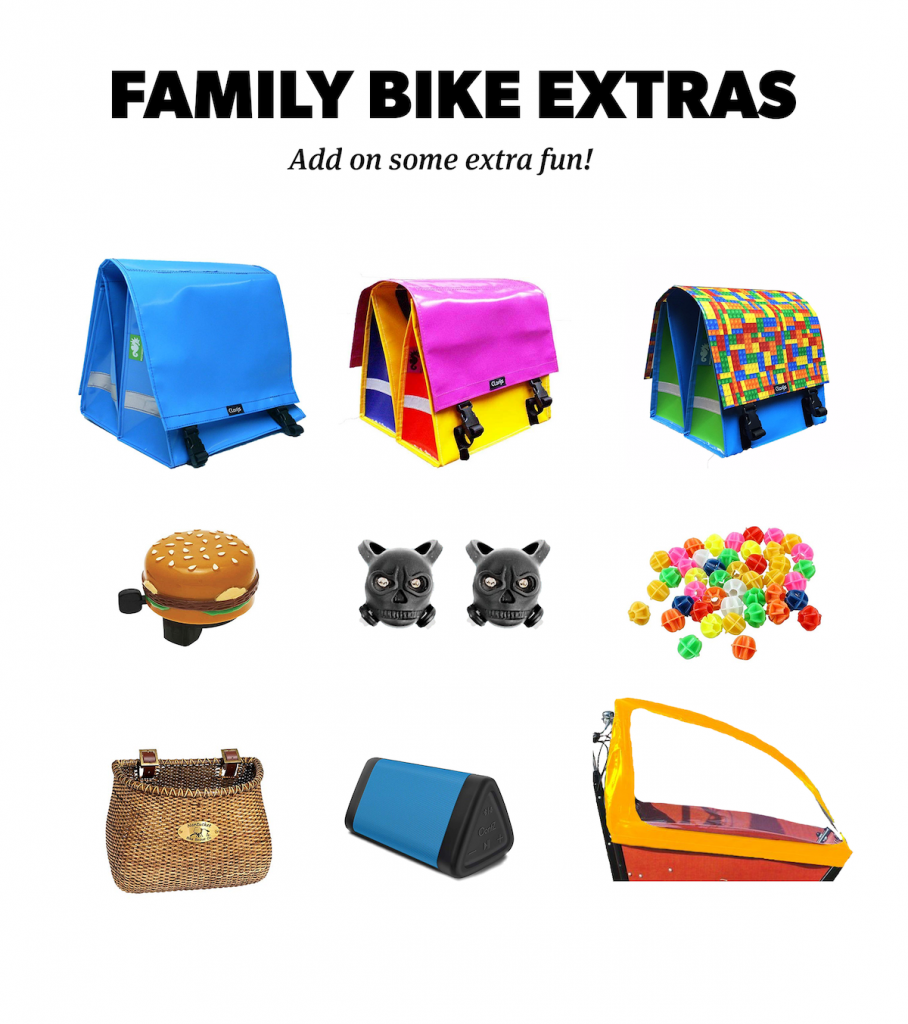
Kid favorites: Hamburger bike bell / Skull LED bike lights / Spoke Beads
Other: Handlebar basket, Portable Speaker, Clarijs Cabrio Tent Canopy (18 colors available!)
Biking Resources
Family-focused bike shops in cities across the US and Canada:
- Four Star Family Cyclery in Chicago
- G&O Family Cyclery in Seattle
- Bike Shop Girl Family Cyclery in Aurora/Denver
- Splendid Cycles in Portland
- J.C. Lind Bike Co. in Chicago
- Reckless Bike Stores in Vancouver
- 718 Cyclery in Brooklyn
- The Bike Center in Los Angeles/Santa Monica
Biking resources and online communities to help you navigate family biking life:
- Our own biking group in the Sidewalk Club private community
- Genepedia is an expert-level blog written by a parent who bikes with her family and reviews all kinds of family bikes with a scientific edge.
Hum of the City is a fantastic blog reviewing nearly every kind of cargo bike on the market. - Chicago Family Biking Community (also on Facebook)
- PDX Bike Gang Facebook Group
- Family Biking Denver Facebook Group
- Active Transportation Alliance is an advocacy group promoting better walking, bicycling, and public transportation throughout Chicagoland.
- Los Angeles County Bicycle Coalition is an advocacy group in LA.
- Sustainable Streets is a Los Angeles non-profit encouraging sustainable transportation and offering in-person bike safety courses.
- Black Girls Do Bike is a community of women who share a passion for cycling and meet up at events across the US.
- Safe Routes Partnership is a non-profit that advocates for safe walking and bicycling to and from schools, to improve the health and wellbeing of kids
- Pedalheads offers camps and lessons that promote kids health and wellness, including bicycling classes!
- Motherload is a beautiful crowdsourced documentary about the magic of family biking. The film argues cargo bikes, in addition to being better for the planet, could be the antidote to the “increasing isolation and disconnection of the digital age.”
Our beautiful custom illustrations were created by Alexandra Mazurina, an artist living in Amsterdam who also happens to bike with her child!
Special thanks to Elsbeth Cool at Four Star Family Cyclery, Davey Oil at G&O Family Cyclery, Barb Grover at Splendid Cycles, co-founder of PDX Cargo Bike Gang Michelle Corbett, and the entire Chicago Family Biking Community for giving encouragement, pre-reading, and offering expert help with this handbook. And a big round of applause to our sponsor, Clarijs bike bags. Support these people!
All information given in the handbook above is meant to be for entertainment and informational purposes only. While we take great care to provide you with accurate information, you are using the information in this handbook (and everywhere on the site) at your own risk. We cannot be held responsible for injuries, disappointments, or any other bummers, large or small. Always seek professional advice. Also, the Sidewalk Club isn’t responsible for any purchases you may chose to make and products purchased through a sponsorship or affiliate link will be your responsibility to resolve. More legal info here, but those are the basics.

